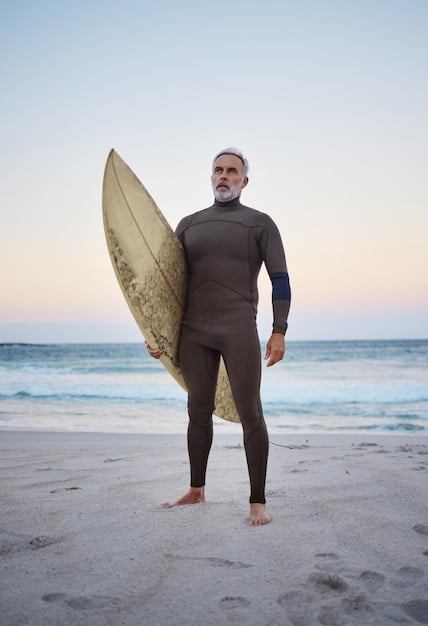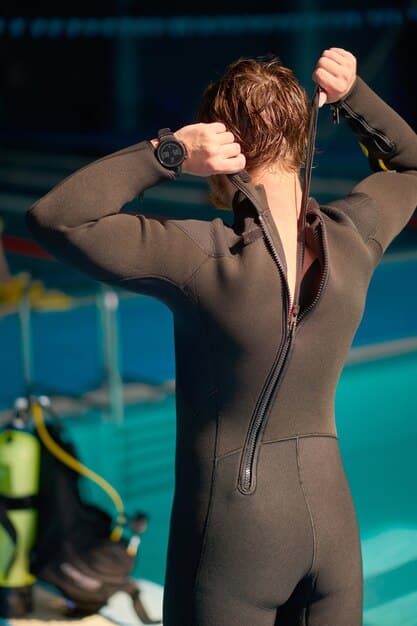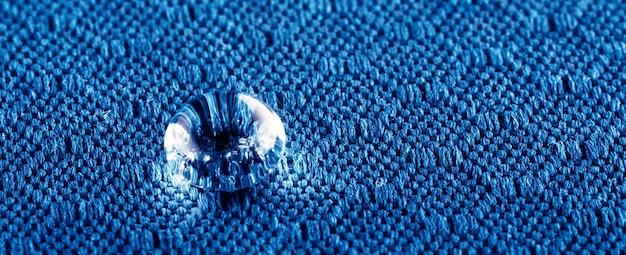Find Your Perfect Fit: Wetsuit Guide 2025 – Thickness, Temp & More

Choosing the right wetsuit involves understanding thickness for water temperature, ensuring a snug fit for optimal insulation, and considering features like sealed seams for enhanced comfort, all of which are crucial for enjoying water activities in 2025.
Planning on hitting the waves or diving into cooler waters? Understanding how to choose the right wetsuit: a 2025 guide to thickness, fit, and water temperature is key to staying comfortable and safe.
How to Choose the Right Wetsuit: Key Considerations
Choosing the right wetsuit can seem daunting, but breaking it down into key considerations makes the process much simpler. From understanding the impact of thickness on warmth to ensuring a proper fit, each factor plays a crucial role in your comfort and performance in the water.
Understanding Wetsuit Thickness
Wetsuit thickness directly impacts how warm you’ll be in the water. Thicker wetsuits provide more insulation, making them ideal for colder temperatures, while thinner suits offer greater flexibility and are better suited for warmer waters.
The Importance of Fit
A well-fitted wetsuit is essential for maximizing warmth and comfort. A loose wetsuit allows water to flush in and out, reducing its insulating properties. Conversely, a suit that’s too tight can restrict movement and cause discomfort.
Here are key considerations to remember when choosing the perfect wetsuit:
- Water Temperature: Always match the wetsuit thickness to the water temperature you’ll be in.
- Activity Level: Consider how active you’ll be. Higher activity levels generate more body heat, allowing you to wear a slightly thinner suit.
- Personal Preference: Some individuals naturally run warmer or colder, influencing their wetsuit needs.
By carefully considering these factors, you can confidently choose a wetsuit that keeps you comfortable and performing your best in the water.
Decoding Wetsuit Thickness: A Temperature Guide
Wetsuit thickness is typically measured in millimeters (mm) and is usually represented by two numbers, such as 3/2mm or 5/4mm. These numbers indicate the thickness of the neoprene in different areas of the suit, providing targeted warmth and flexibility.
Understanding Neoprene Thickness
The first number represents the thickness of the neoprene in the torso area, which is crucial for maintaining core body temperature. The second number indicates the thickness in the arms and legs, where flexibility is more important.
Recommended Thickness by Water Temperature
Here’s a general guideline for choosing the appropriate wetsuit thickness based on water temperature:
- 75°F (24°C) and Up: 2mm or less (Shorty or Spring Suit)
- 68-75°F (20-24°C): 2/1mm or 3/2mm
- 62-68°F (16-20°C): 3/2mm or 4/3mm
- 56-62°F (13-16°C): 4/3mm or 5/3mm
- Below 56°F (13°C): 5/4mm or thicker (with booties, gloves, and hood)

Selecting the right thickness ensures you stay warm without sacrificing mobility, allowing you to fully enjoy your water activities. Remember to adjust based on your personal cold tolerance and the specific conditions of your chosen location.
Finding the Perfect Fit: Wetsuit Sizing and Styles
A properly fitted wetsuit is your first line of defense against the cold. Understanding the different wetsuit styles and how they cater to various activities is essential to maximizing your comfort and performance in the water.
Wetsuit Styles
Wetsuits come in various styles, each designed for specific activities and conditions. Full suits provide full coverage and maximum warmth, while shorties offer greater freedom of movement in warmer waters. Spring suits are a hybrid, with short sleeves and legs, ideal for mild conditions.
Sizing and Fit Tips
When trying on a wetsuit, pay close attention to the fit in key areas such as the shoulders, chest, and crotch. The suit should feel snug but not constricting, allowing a full range of motion without excessive looseness.
Consider these factors when assessing wetsuit fit:
- Snug Fit: The wetsuit should fit snugly against your body to trap a thin layer of water that your body will heat up.
- Range of Motion: Ensure you can move your arms and legs freely without feeling restricted.
- Seam Placement: Check that the seams don’t chafe or irritate your skin, especially in areas prone to friction.
Finding the right fit ensures optimal warmth and comfort, allowing you to focus on enjoying your time in the water.
Wetsuit Features: Zippers, Seams, and Linings
Beyond thickness and fit, specific wetsuit features can significantly impact performance and comfort. Zippers, seam construction, and internal linings all play a role in determining how well a wetsuit keeps you warm and allows you to move freely.
Zipper Types
Wetsuits commonly feature back zips, chest zips, or zipperless designs. Back zips are easy to get in and out of but can limit flexibility. Chest zips offer greater flexibility but may require more effort to put on. Zipperless suits provide maximum flexibility but can be challenging to enter and exit.
Seam Construction
Seam construction is critical for preventing water entry and maintaining warmth. Flatlock seams are common in warmer water suits, while glued and blindstitched (GBS) seams offer superior water sealing for colder conditions. Taped seams provide extra reinforcement and durability.
Here are some common seam types and their benefits:
- Flatlock Seams: Comfortable and durable, ideal for warmer water.
- Glued and Blindstitched (GBS): Watertight and flexible, suitable for colder water.
- Taped Seams: Reinforced and durable, providing extra protection against water entry.
Choosing a wetsuit with appropriate features can greatly enhance your comfort and performance in the water, allowing you to stay warmer and more flexible for longer periods.
Wetsuit Materials: Neoprene Types and Innovations
Neoprene is the primary material used in wetsuits, but not all neoprene is created equal. Different types of neoprene offer varying levels of flexibility, insulation, and durability, impacting the overall performance of the wetsuit.

Types of Neoprene
Traditional neoprene is petroleum-based, while more environmentally friendly options like limestone neoprene and Yulex offer sustainable alternatives. Limestone neoprene is more flexible and durable than traditional neoprene, while Yulex is a plant-based material derived from rubber trees.
Material Innovations
Manufacturers are constantly innovating to improve wetsuit materials. Some wetsuits feature internal linings made from quick-drying materials like fleece or thermal fibers, which enhance warmth and comfort. Outer layers may be treated with water-repellent coatings to minimize water absorption.
Consider these material properties when choosing a wetsuit:
- Flexibility: More flexible neoprene allows for a greater range of motion.
- Insulation: Higher insulation keeps you warmer in colder water.
- Durability: More durable materials resist wear and tear, extending the life of your wetsuit.
Selecting a wetsuit with advanced materials ensures optimal performance and comfort, allowing you to stay in the water longer and enjoy your activities to the fullest.
Caring for Your Wetsuit: Maintenance and Storage Tips
Proper care and maintenance are essential for extending the life of your wetsuit. Regular cleaning and proper storage prevent damage and maintain its performance.
Cleaning Your Wetsuit
After each use, rinse your wetsuit thoroughly with fresh water to remove salt, sand, and other debris. Use a mild wetsuit shampoo or detergent occasionally to remove stubborn dirt and odors. Avoid using harsh chemicals or bleach, which can damage the neoprene.
Storage Tips
Store your wetsuit in a cool, dry place away from direct sunlight. Hang it on a wide hanger to prevent creases and compression. Avoid folding or stuffing it into a bag, which can damage the neoprene over time.
Follow these guidelines to keep your wetsuit in top condition:
- Rinse After Each Use: Remove salt and debris to prevent damage.
- Use Mild Soap: Clean periodically with wetsuit shampoo.
- Hang Properly: Store on a wide hanger in a cool, dry place.
By following these simple care and maintenance tips, you can extend the life of your wetsuit and ensure it continues to perform at its best for years to come.
Wetsuit Accessories: Booties, Gloves, and Hoods
In colder water conditions, wetsuit accessories such as booties, gloves, and hoods are essential for maintaining warmth and comfort. These accessories provide additional insulation to areas prone to heat loss, allowing you to stay in the water longer.
Booties
Wetsuit booties protect your feet from the cold water and provide traction on slippery surfaces. They come in various thicknesses and styles, including round toe and split toe designs. Choose booties that fit snugly but allow for comfortable movement.
Gloves
Wetsuit gloves keep your hands warm and improve grip. They come in various thicknesses and styles, including full finger and open palm designs. Choose gloves that fit snugly but allow for dexterity.
Hoods
Wetsuit hoods protect your head and neck from the cold water, minimizing heat loss and improving overall warmth. They come in various thicknesses and styles, including attached and detachable designs. Choose a hood that fits snugly but doesn’t restrict breathing.
Here’s how to choose the right accessories for your wetsuit:
- Consider Water Temperature: Choose thicker accessories for colder water.
- Ensure Proper Fit: Accessories should fit snugly but not constricting.
- Match Activity: Select accessories that suit your specific water activity.
By adding these accessories to your wetsuit setup, you can extend your time in the water and enjoy your activities even in the coldest conditions.
| Key Aspect | Brief Description |
|---|---|
| 🌡️ Thickness | Match thickness to water temp for warmth. |
| 📏 Fit | Snug fit prevents water flushing and maximizes insulation. |
| 🌊 Seams | Choose GBS or taped seams for cold water. |
| 🧤 Accessories | Use booties, gloves, and hoods in cold conditions. |
Frequently Asked Questions (FAQs)
For 60°F (15°C) water, a 4/3mm or 5/3mm wetsuit is generally recommended. This thickness provides ample insulation to keep you warm while allowing reasonable flexibility for various water activities.
A wetsuit should fit snugly against your body, like a second skin, to trap a thin layer of water that your body will heat up. It should not be too tight, restricting movement, or too loose, allowing water to flush in and out.
Flatlock seams are stitched through the neoprene, creating a comfortable but less watertight seal, suitable for warmer water. Glued and blindstitched (GBS) seams are glued and stitched without fully penetrating the neoprene, creating a more watertight seal for colder water.
Rinse your wetsuit with fresh water after each use to remove salt and debris. Occasionally, use a mild wetsuit shampoo. Hang it on a wide hanger in a cool, dry place away from direct sunlight to prevent damage and maintain its elasticity.
Wetsuit booties are highly recommended for colder water conditions. They provide insulation for your feet, which are prone to heat loss, and offer protection and traction on slippery surfaces, enhancing overall comfort and performance.
Conclusion
Choosing the right wetsuit for your needs involves careful consideration of thickness, fit, features, and materials. By understanding these key aspects and tailoring your choice to your specific activities and conditions, you can ensure maximum comfort and performance in the water, making your aquatic adventures more enjoyable and safe.





